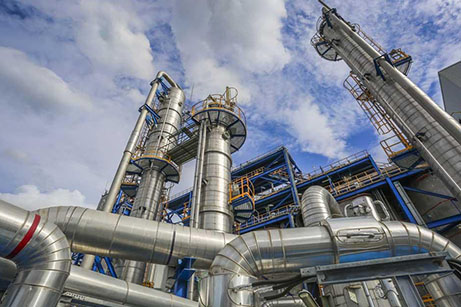Por qué el acero inoxidable 309S es el héroe inadvertido en las industrias de alta temperatura
In our everyday kitchens, 304 stainless steel is the go-to material for cookware due to its excellent corrosion resistance and ease of processing. However, in industrial settings, especially in extreme high-temperature and corrosive environments, a stronger material—309S stainless steel—quietly takes on the role of a protector. Today, we will uncover this indispensable material in industrial high-temperature applications and how it has become an unsung hero in the industry.

309S Stainless Steel: The Guardian of High-Temperature Industries
Imagine placing a pot of hot soup on the stove—the material of the pot must withstand sustained high temperatures without losing its shape or performance. This is the limit for 304 stainless steel, but for 309S, it's just a minor challenge. 309S stainless steel can maintain stability at temperatures as high as 980°C, making it an essential material in industrial environments such as high-temperature furnaces, heat exchangers, chimney linings, and automotive exhaust systems.
The Chemical Composition of 309S Stainless Steel: The Source of Its Power
The strength of 309S stainless steel lies in its chemical composition. It contains carbon (C) no more than 0.08%, manganese (Mn) no more than 2.00%, silicon (Si) no more than 1.00%, phosphorus (P) no more than 0.045%, sulfur (S) no more than 0.030%, nickel (Ni) between 12.0-15.0%, and chromium (Cr) between 22.0-24.0%. These elements not only grant 309S excellent corrosion resistance but also provide it with outstanding mechanical properties, including a yield strength of no less than 205 MPa, tensile strength of no less than 515 MPa, elongation of no less than 40%, and a reduction of area of no less than 50%.
|
Chemical Composition of Type 309s |
|
| Element | Percentage (%) |
| Carbon (C) | ≤0.08 |
| Manganese (Mn) | ≤2.00 |
| Silicon (Si) | ≤1.00 |
| Chromium (Cr) | 22.0 - 24.0 |
| Nickel (Ni) | 12.0 - 15.0 |
| Phosphorus (P) | ≤0.045 |
| Sulfur (S) | ≤0.030 |
| Nitrogen (N) | ≤0.10 |
| Iron (Fe) | Balance |
However, boasting alone is not enough to prove its superiority. When compared to other high-temperature materials— including other high-temperature stainless steel grades—309S still shows its unique advantages.
309S vs Other High-Temperature Materials
309S stainless steel showcases multiple advantages in the comparison of high-temperature materials, especially in terms of stability in high-temperature environments, corrosion resistance, and workability. Here’s a breakdown of how it compares with other materials:
Molybdenum (Mo)
- Advantages: Molybdenum has an extremely high melting point (around 3,200°C) and excellent high-temperature oxidation resistance, making it ideal for extreme high-temperature environments like aerospace engines.
- Disadvantages: Molybdenum has a high density (around 10.2 g/cm³), making it cumbersome for some applications, and its cost is high, limiting its widespread use.
- 309S Comparison: While the melting point of 309S is relatively lower (about 1,400°C), its density (about 7.9 g/cm³) is much lower, and it is more cost-effective. 309S offers good high-temperature performance for applications with high but not extreme temperatures.
Silicon Carbide and Silicon Nitride Ceramics
- Advantages: Silicon carbide (SiC) and silicon nitride (Si3N4) ceramics have excellent high-temperature (can withstand above 1,600°C) and corrosion resistance, widely used in power generation and aerospace fields.
- Disadvantages: Ceramics are brittle and prone to cracking, difficult to process, and costly.
- 309S Comparison: 309S stainless steel offers better toughness and workability, capable of withstanding mechanical loads without easily breaking. Compared to ceramics, 309S is more flexible in processing and welding and is more cost-effective.
Carbon Fiber
- Advantages: Carbon fiber is lightweight and high-strength, commonly used in aerospace and rocket engines, particularly in structural components like nozzles.
- Disadvantages: Carbon fiber has poor corrosion resistance and is complex to process, with a high cost.
- 309S Comparison: 309S stainless steel has superior corrosion resistance, especially in environments containing sulfur compounds or other corrosive gases. While 309S is heavier, its overall performance is more balanced, making it suitable for a wider range of applications.
309S stainless steel excels in its comprehensive performance. It can remain stable in high-temperature environments up to 980°C for long periods, and it offers better mechanical strength, toughness, and workability compared to many high-temperature materials like molybdenum, silicon carbide ceramics, and polyimide. Furthermore, 309S's corrosion resistance, especially in sulfur-containing environments, outshines most other high-temperature materials. Therefore, 309S stainless steel is a more balanced and cost-effective choice in many applications requiring high temperature, corrosion resistance, mechanical strength, and good processability.
You might wonder, given that 309S is stainless steel, it naturally inherits the “corrosion resistance” properties typical of stainless steel, almost as if it were born with a “golden key” to success. However, if you compare 309S with other stainless steel grades, would your perspective change? Next, we will dive into why 309S stands out among stainless steels in industrial applications and why it is a superior choice.
309S vs 309 Stainless Steel
Both 309S and 309 stainless steels are similar in chemical composition and physical properties but differ in key aspects that affect their performance in specific applications.
Chemical Composition and Carbon Content
309S Low carbon content (max 0.08%) for better high-temperature stability and reduced carbide precipitation, improving corrosion resistance.
309 Higher carbon content (max 0.20%), leading to slightly lower corrosion resistance due to carbide formation at high temperatures.
High-Temperature Performance & Corrosion Resistance
309S Better corrosion resistance at temperatures up to 980°C, particularly in corrosive environments (e.g., sulfides). Ideal for high-temperature furnaces and heat exchangers.
309 Performs well at temperatures up to 980°C but has reduced corrosion resistance in harsh conditions due to higher carbon content.
Cost & Application Choice
309S More complex to manufacture, higher cost, but superior stability and oxidation resistance in harsh environments.
309 More cost-effective and suited for environments with high temperatures but less corrosive challenges.
In general, 309S and 309 exhibit similar performance in high-temperature environments, but 309S's low carbon content provides stronger corrosion resistance and better high-temperature stability, especially in environments with corrosive substances like sulfides. 309, on the other hand, is more suitable for high-temperature environments where corrosion is less of a concern, and it is more cost-effective.
| Propiedad | Acero inoxidable 309S | 309 Stainless Steel |
| Maximum Carbon Content | 0.08% | 0.20% |
| High-Temperature Corrosion Resistance | Superior, especially in environments with sulfides and other corrosive gases | Slightly lower, more prone to carbide formation at high temperatures |
| High-Temperature Performance | Maintains better stability at temperatures up to 980°C | Performs well up to 980°C but less stable in extreme conditions |
| Application Suitability | Ideal for high-temperature, corrosive environments (e.g., furnaces, heat exchangers) | Suitable for high-temperature applications with less severe corrosion conditions |
| Cost | Higher due to lower carbon content and more complex manufacturing | Lower due to higher carbon content and simpler production |
| Mechanical Properties | Similar strength, ductility, and toughness as 309, but more resistant to corrosion under extreme conditions | Similar to 309S but more vulnerable to corrosion in certain environments |
| Corrosion Resistance in High-Temperature Environments | Excellent corrosion resistance due to lower carbon content | Good but less resistant in long-term high-temperature exposure, especially with corrosive gases |
309S Stainless Steel vs Other Stainless Steel Grades
When compared to other high-temperature stainless steel grades, 309S stands out for its unique irreplaceable characteristics. Here’s how 309S compares to several other high-temperature stainless steel grades:
- 309S vs 304 Stainless Steel: 309S offers superior high-temperature performance compared to 304 stainless steel, which is typically used in environments with temperatures not exceeding 500°C. In contrast, 309S can be used in temperatures as high as 980°C.
- 309S vs 310S Stainless Steel: 310S stainless steel is designed for even higher temperatures, able to withstand up to 1375°C. While 310S offers better high-temperature performance, 309S excels in corrosion resistance, especially in sulfur-containing environments.
- 309S vs 321 Stainless Steel: 321 stainless steel uses titanium to stabilize the austenitic structure and prevent chromium carbide formation at high temperatures, thereby maintaining corrosion resistance. However, 309S, with its high chromium and nickel content, offers superior overall performance in both high-temperature and corrosion resistance.
- 309S vs 347 Stainless Steel: 347 stainless steel uses niobium to stabilize the austenitic structure and is suitable for temperatures up to 1,093°C. While 347 has excellent high-temperature oxidation resistance, 309S offers better cost-effectiveness and workability.
- 309S vs 316L Stainless Steel: 316L contains molybdenum, which enhances its corrosion resistance in chloride environments, making it suitable for high-temperature and corrosive applications. However, 309S excels in high-temperature resistance and carburization resistance, particularly in terms of mechanical strength at high temperatures.
Conclusion: 309S Stainless Steel, The Quiet Giant of the Industry
Although 309S stainless steel may not be as widely known as other types of stainless steel, its irreplaceable role in certain industries makes it a quiet hero in the industrial world. Much like those unsung superheroes working behind the scenes, 309S stainless steel steadfastly protects the safety and stability of our industries in the battle against high temperatures and corrosion. Next time you pick up heat-resistant cookware, think about the powerful support it might have behind the scenes—309S stainless steel. This silent hero is a crucial safeguard for industrial safety.
Need the protection from SS309S? Contáctenos today!







